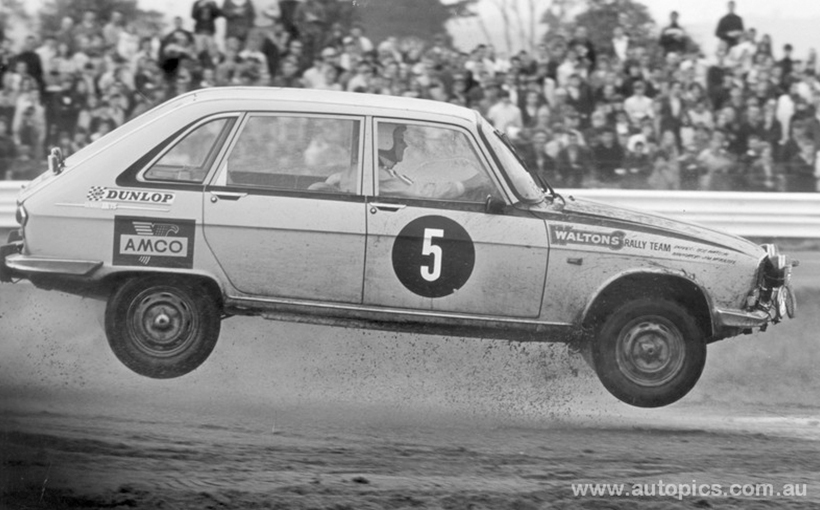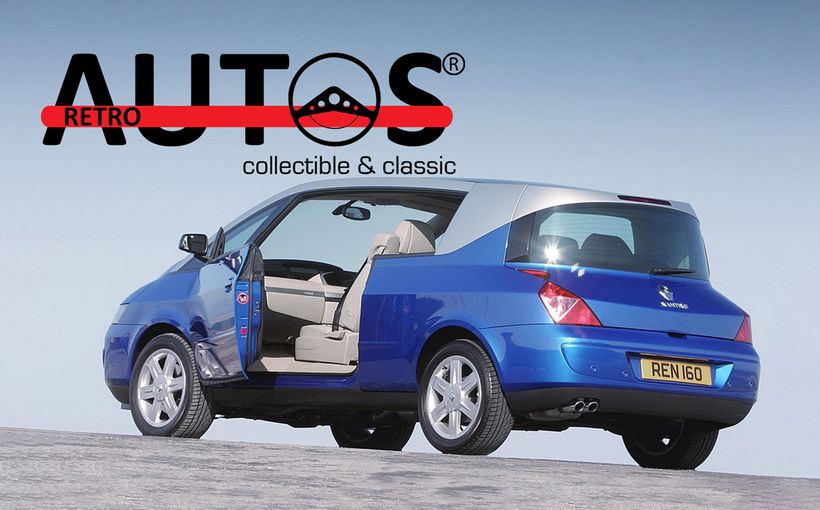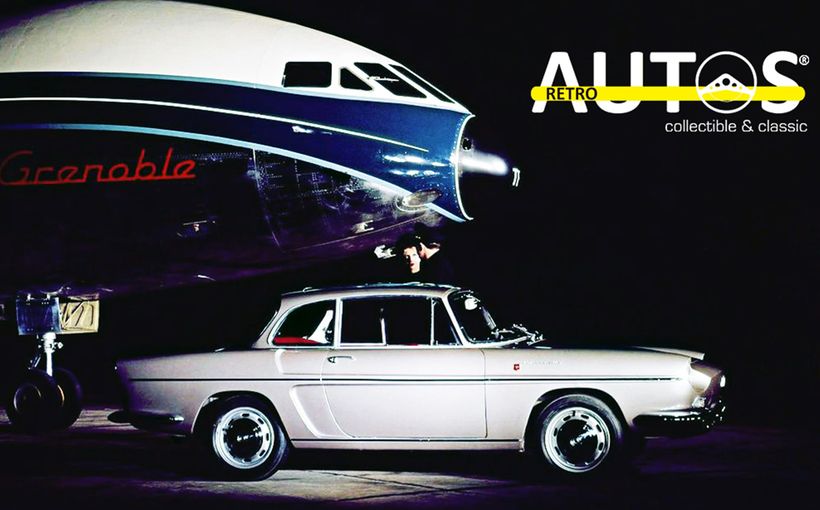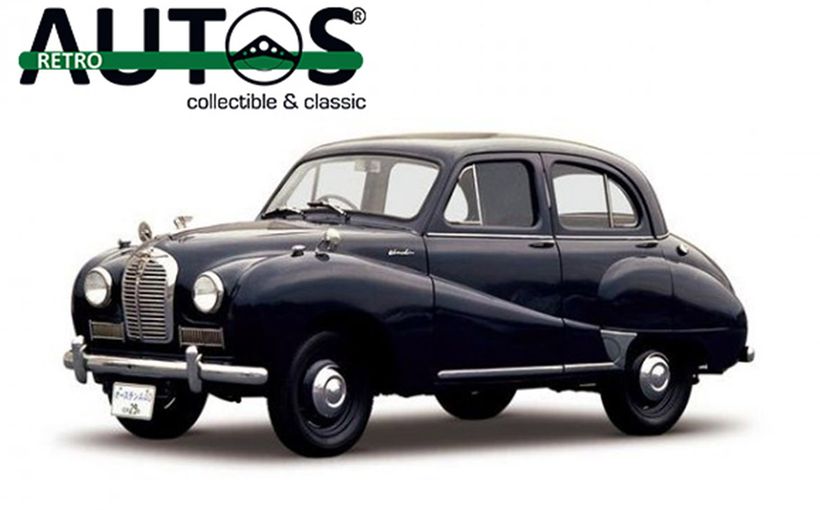Renault 16TS: The quirky French sedan that beat a Porsche 911

The champs! Bob Watson and Renault became synonymous in the early 1970s, as the rally ace and the French car maker helped to build strong Australian sales and customer loyalty through rallying success. Here Watson and his ‘works’ 16TS get airborne at a muddy Calder Park in 1969 in the new sport of rallycross.
“We really surprised ourselves because we certainly didn’t expect to topple a works-prepared Porsche 911,” Bob Watson told Shannons Club as the former rally ace reflected on his famous against-the-odds victory with navigator Jim McAuliffe aboard a Renault 16TS in the 1969 Victorian Rally Championship.
“We also amazed Renault, they were just over the moon. It was a pivotal win really because that’s when they decided to get really serious and committed to a full factory-backed program with the R8 Gordinis in 1970, when we won the Australian Rally Championship.”
Motor sport history is dotted with examples of how cars which were not expected to be competitive managed to win against the odds. Watson and McAuliffe managed to do just that when they toppled an ex-works London to Sydney Marathon Porsche 911 to clinch the Victorian title.

The factory-prepared Porsche 911T shared by Edgar Herrmann and Hans Schuller in the 1968 London to Sydney Marathon was destined to continue its rallying career in Australia, where it faced some surprisingly tough competition from Renault. This is how the car looked during the ’68 Marathon, fitted with extensive framework for carrying extra equipment and protection from straying wildlife.
The 1969 series (officially the Victorian Trials Championship in those days) was conducted over seven rounds held in various parts of the state, covering a variety of challenging terrain from the snow-capped peaks of the Alps to the flat forests of the Victorian Goldfields. Although Renault Australia was well represented with two factory-prepared 16TS models, the potent ex-Marathon Porsche 911T had been expected to dominate.
The Porsche was one of three prepared by the marque’s competition department in Weissach, Germany for the 1968 London to Sydney. Crewed by the African-based German pairing of Edgar Herrmann and Hans Schuller, it finished 15th outright. One of its stablemates retired with engine troubles while the third car, a 911S driven so forcefully by the Polish crew of Sobieslav Zasada and Marek Wachowski, finished fourth outright.
Following the Marathon, Hermann sold his 911T to Australian Porsche distributor and racer Alan Hamilton. He converted it to right-hand drive and Victorian rego to compete in rallies under the ‘Porsche Distributors’ banner, driven by Tony Roberts (who won Bathurst that year with Colin Bond in an HDT Monaro) and navigator Mike Osborne.

This is how the ex-Herrmann/Schuller 911T looked in 1969, with most of its external framing from the Marathon removed and converted to right hand-drive for local rallies. Here Tony Roberts gives the famous Porsche a brutal workout at a Calder Park rallycross meeting that year.
The factory-prepared German thoroughbred, with its fully seam-welded tank tough body and potent 2.0 litre flat-six, combined fantastic rear wheel traction (thanks to its rear engine location) with an athletic power-to-weight ratio.
Stripped of most of its Marathon equipment, it was an even faster forest racer that brought its own exotic brand of excitement to the Victorian rally scene in 1969. As Racing Car News magazine described it at one event: “The harsh blood-stirring cackle of the orange Porsche’s exhaust could be heard for miles across the flat countryside.”
Trying to knock off such a potent car and driver combination with the humble 16TS looked like little more than wishful thinking by Renault Australia. Launched to wide acclaim in 1965, the original Renault 16 captured the motoring world’s imagination with its innovative five-door hatchback design, which provided unmatched versatility and an interior that could be configured in a variety of ways including a comfortable bed.

Watson and McAuliffe were the reigning Victorian rally champions in 1969 having claimed their first state title the previous year in a big HK Holden Kingswood V8. Watson adapted his driving style to squeeze the most out of the smaller capacity Renault 16TS with great results. Here the champs are seen charging through the dust in the 1969 Southern Cross Rally, when terry towelling hats were still popular head protection for rally crews. Image: www.bobwatsonrally.com.au
Inspired engineering could also be seen in the precise rack and pinion steering, powerful front disc brakes and plush-riding yet responsive torsion bar suspension (with unequal left and right wheelbase lengths to accommodate the rear torsion bars) designed to iron out the roughest of French colonial roads with consummate ease.
Sports car aficionados were no doubt impressed by its genuine ‘mid-engined’ layout. The longitudinally-mounted 1.4 litre all-aluminium pushrod four was buried deep into the notched firewall with its gearbox/transaxle unit mounted ahead of it to drive the front wheels, in a similar fashion to Citroen’s ground-breaking Traction Avant and DS. The four-speed gearbox was controlled by a nicely-weighted column shift to maximise interior space.
The arrival of the faster and sportier TS (Tourisme Sport) variant of the Renault 16 in 1968 brought with it a much needed boost in engine capacity from 1.4 to 1.6 litres (or 1565cc). The TS’s superb Gordini-designed cross-flow cylinder head featured hemispherical combustion chambers and wide valve angles, which with its twin-choke Weber carburettor was good for 83 bhp at 5700 rpm and 87 ft/lbs of torque at 3500 rpm.
With a kerb weight of around 1060 kgs, the 16TS was claimed to be capable of 100 mph (160 km/h) top speeds. Combined with its supple long travel suspension, excellent front/rear weight distribution and responsive sure-footed handling, the French sedan was well suited to rugged Aussie roads and bush tracks and formed the basis of Renault’s 1969 attack.

Former Holden team-mates became arch rivals in 1969, with Tony Roberts in a Porsche 911 and Bob Watson in a Renault 16TS facing off in the Victorian Rally Championship. Here Roberts and Watson are sloshing through the mud at Calder Park’s first rallycross meeting in 1969. Image: www.porscheforum.com.au
Watson goes Renault, Roberts goes Porsche
Bob Watson/Jim McAuliffe and Tony Roberts/Mike Osborne had been team-mates in the early days of Holden’s in-house rally operation (Victorian Holden Dealers Rally Team) which was run from the service garage at the company’s Melbourne HQ at Fishermen’s Bend in the 1960s.
Their rivalry was at its most intense in the 1968 Victorian Rally Championship, when both crews drove factory-prepared HK Kingswoods fitted with specially tuned 307 cid (5.0 litre) Chev V8s and two-speed Powerglide auto transmissions. Watson/McAuliffe prevailed in a fierce inter-team battle with Roberts/Osborne, winning five of six rounds to wrap up the 1968 VRC in convincing style. However, no sooner had the champagne corks popped that both crews were out of a drive.
“When Holden announced the discontinuation of their rally team in late 1968, there was a mad scramble to get some sort of drive for the following year,” Watson explained. “Tony Roberts was quick off the mark and secured the use of the ex-London to Sydney Porsche 911. With Mike Osborne navigating, this looked a hard combination to beat.
“I was contacted by Geoff Key, the marketing manager of Renault Australia. The company had been running a limited Australian rally program, but with the new Renault 16 (and later Renault 12) coming on to the market the company wanted to expand their effort. I was offered a drive in the new 16TS model for 1969 and I asked Jim McAuliffe to navigate.

Watson/McAuliffe’s Renault team-mates in 1969 were Mal McPherson and Rob Sharpley. Here the 1967 BP Rally winners are splashing through a creek at high speed in their works-prepared 16TS. Image: www.bobwatsonrally.com.au
“The Renault rally program was being looked after - in a fashion - by Captain Peter Janson, the well-known Melbourne playboy, rally and race driver, polo player and bon vivant. He had arranged some sponsorship for the rally team through Kays Rent-A-Car (which had Renaults on fleet) and the trade union-owned Waltons department store.
“Janson invited me to go to the factory in West Heidelberg to pick up a Renault 16 so that I could familiarise myself with it, so I went out there and met with the executives including Geoff Key along with the rally crew which included the chief mechanic, my late friend Enzo Dozzi, and the good Captain himself.
“Janson then looked around for a car to give me. He randomly selected a purple Renault 16 (the original 1.4 litre model) which was immediately christened the ‘Purple People Eater’. I must say that my first drive was thoroughly disheartening. I’d become used to cubic capacity and V8 power and this car felt like some kind of wind-up toy. The engine would certainly rev though and the car’s ride on rough surfaces was outstanding. The brakes were good, but they weren’t being asked to do much. Then I thought of Roberts in the Porsche and my hopes of defending my 1968 VRC title faded to very dim.”

In the early 1970s Renault had built a batch of cars with wrong length front shock absorbers, which resulted in bent lower wishbones. This was giving the cars a bad name in Western Australia so local agent Rod Slater (Eurocars) entered a stock 16TS in the first WA round of the Australian Rally Championship in 1974 and asked Watson to drive with navigator Rod Van Der Straaten. The car was measured up by the RACWA before the rally and Slater ran a full-page ad in the WA newspaper announcing the car was to run in the rally and be measured again after the event. He also told Watson to drive the hell out of it, which he did finishing third outright. RACWA measured the car again after the event and everything was perfect. Watson said it was “a ballsy effort” by Rod Slater. Image: www.bobwatsonrally.com.au
However, it was a factory drive and given that there was no alternative ride available, Watson committed himself to doing the best job he could for his new employer. A key focus was on his driving technique and what he would have to change in his transition from a big V8 rear wheel-drive HK Kingswood in 1968 to a four cylinder front wheel-drive in 1969.
Enzo Dozzi prepared two of the newly released Renault 16TS models at Renault Australia’s service garage at West Heidelberg. One car was for reigning champs Bob Watson/Jim McAuliffe, with the other crewed by Mal McPherson and navigator Rob Sharpley who had won the BP Rally for Renault in 1967.
Janson would drive one of the hot new R8 Gordinis, along with Colin Wilson, so if nothing else the French car maker had strength in numbers against the lone wolf Porsche. The German coupe was expected to be the ‘hare’ which the French ‘tortoises’ would have to chase, but Renault did have a trick or two up its sleeve to boost the performance of the 16TS pair.

Although lacking European factory support, the Renault 16TS competed in major rallies around the world including the famous East African Safari and Monte Carlo events. Here the privately-entered Van Lennup/Dik Sur 16TS is seen tackling a steep snow-affected stage of the 1971 Monte Carlo, in which its front wheel-drive design struggled against the rear-engined rear wheel-drive Renault Alpine A110s which dominated the event. Image: www.gomotors.net
“We did have some work done on the engines but there’s been some confusion since about whether Harry Firth did it or Repco Research,” Watson said. “Renault had spoken with Harry in ‘69, just after Ford had given him the flick and he hadn’t yet hooked up with Holden. I know he did at least one rally for Renault driving a 16.
“My understanding though is that it was done by Repco. What they did was cut a hole in the dash panel to make room for twin 45mm side-draught Webers. They also made an extractor exhaust system which was the most hideous thing you’ve ever seen, as it went out of the right-hand side of the engine and then curled over to the left-hand side because that was the only way you could pipe it down to the back. I think there were also hotter cams and a few other things. Renault claimed these mods made about 120 horsepower (83 hp stock). We could safely rev them to 6500-7000 rpm all day long. The TS was a very sweet engine which thrived on revs.
“The column shift in those cars was beautiful, as good as any floor shift you could ask for. It was very precise and nicely weighted across the gate. You never had to think about it; you just put your hand on the lever and it changed gear.

Watson and McAuliffe (note Jim’s cigarette) proceed to the start of a night stage in their immaculately prepared VRC-winning Renault 16TS. Apart from some basic engine modifications to improve performance along with installation of the usual rally gear, these cars remained very close to stock standard. We can’t even see a roll cage. Image: www.bobwatsonrally.com.au
“They fitted the usual things like sump guards, driving lights and navigation equipment but the suspension and brakes were left pretty much standard and there was no limited slip diff. So you just learned to live with the large amount of body roll they had with the torsion bars and modified your driving style to keep the front wheels flat on the ground, because if you lifted an inside front through a corner it would just start to spin and you’d go nowhere.
“I reckon our cars would have weighed less than 1000 kg (kerb weight 1060 kg). The 16 had this really complex arrangement of seats which you could put in all sorts of different positions, but they were quite heavy so we just took them all out and anything else that wasn’t needed.”

Watson and McAuliffe cornering at high speed during the 1969 BP Rally. Note how composed their 16TS looks. Despite the large amount of body roll, the supple long-travel torsion bar suspension is allowing the inside wheels to remain in full contact with the heavily cambered road surface. These cars were brilliant performers on rough terrain and ideally suited to tough Aussie conditions. Image: www.bobwatsonrally.com.au
1969 Victorian Rally Championship
Much to everyone’s surprise, the works Porsche 911 did not run away with the Victorian title. Although records of the 1969 VRC are thin on detail, what is clear from our research is that the Porsche crew experienced some unexpected hiccups along the way - including at least one costly navigational error - which ensured that the works Renaults were able to apply maximum pressure from the start.
A dazzling Renault 1-2 for Janson (R8 Gordini) and Watson (16TS) in the snow-affected opening round (Akademos Rally) set up an intriguing battle. Roberts and Osborne responded with a hard-fought victory for the Porsche in round two (Experts Rally) before Watson hit back in round three leading home a Renault 1-2-3 clean sweep (Blue Ribbon Rally) ahead of the Porsche in fourth place. Watson and McAuliffe were looking good to defend their title with another win in round four (George Derrick Trial) after the Porsche crew only salvaged sixth place.
Watson and McAuliffe then sealed the 1969 VRC – their second title in succession - after another strong performance in round five (VADC Two-Day). The Renault pair then finished a troubled fourth behind team-mates McPherson/Sharpley in round six (North-Eastern Caltex Trial) before choosing to skip the final round to concentrate on preparations for 1970.

Although the Renault 16’s competitive strengths were best displayed in rallying, that didn’t stop Bill Bryden and John Smith entering a lone 16TS in the 1969 Hardie-Ferodo 500 at Bathurst. Back in those days you could literally race a car straight off the showroom floor and the more unusual the car, the better chance of having your entry accepted. Bryden/Smith stood no chance of beating much faster Mini Cooper S and Fiat 125 rivals in Class C (for cars $2251-3100) but they did enjoy a reliable run to finish 10th in class and 12 laps behind the winning Cooper S.
“Remarkably, the Porsche did not run away from us,” Watson reflected. “Anywhere it was rocky and uphill, the 16 was very slow. With front wheel-drive and no limited slip diff it was a real battle, just like the Renault 12 that came along after the (rear-engined rear wheel-drive) R8 Gordini.
“In some conditions, though, like the flat and narrow tracks in the Goldfields (near Ballarat) the 16TS was actually faster than the Porsche. It was really good there; you’d leave it in second, rev the hell out of it and just steer it through the trees at very high speeds. And they were also rugged and reliable, which allowed us to string together some good results. It was a very satisfying victory.”
‘Anti-ordinary’ Renault Australia was an enthusiastic advertiser when it came to trumpeting its rallying results in the press. The 16TS’s Porsche-pummelling success in the 1969 VRC triggered a national advertising blitz with a full-page ad titled: ‘Anti-ordinary’ is winning more rallies than anyone else.”

As powerful driving lights and photographers’ flash bulbs light up the night sky, Watson and McAuliffe erupt out of the darkness at full tilt during the 1969 Southern Cross International Rally. For its time the Renault 16 was a ground-breaking car in so many ways and decades later is still revered around the world by loyal enthusiasts. Image: www.bobwatsonrally.com.au
The text claimed that “covering all 39 International, Australian and State Championship events held in Australia during 1969” Renault claimed more wins (R8 Gordini and R16 combined) than any other manufacturer competing in the sport. It was certainly an impressive statement and a launching pad for the company’s successful assault on the Australian title the following year.
Bob Watson’s only regret about his time with the Renault 16 was what happened to his ‘Purple People Eater’ loan car. Being an honest man he did the right thing, of course, but couldn’t help questioning the financial value of his integrity.
“Mid-way through 1969 I still had the purple car at my home,” Bob recalled with a chuckle. “No one had asked me for it but I thought I should return it to the factory. When I did, no one knew what it was or to whom it belonged. Security searched their paperwork but there was no record of the car belonging to any Renault department. I left it there anyway, but it occurred to me later that I could have sold the thing and no one would have been any the wiser!”









